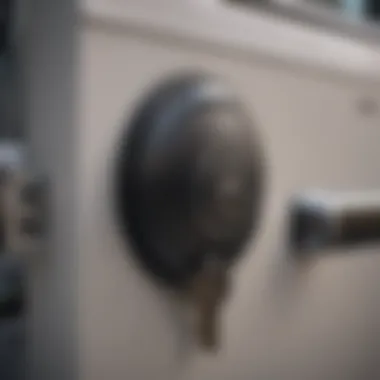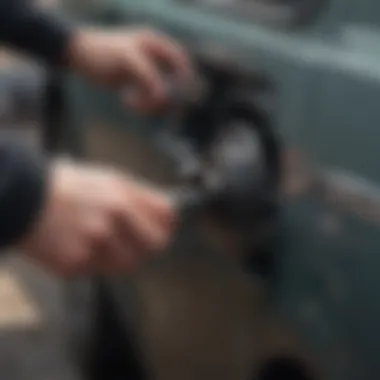Understanding Car Door Lockouts: Solutions & Prevention


Intro
Car door lockouts can happen to anyone, and their frequency may surprise you. Whether it's a busy morning or a late night at the grocery store, forgetting your keys inside the car is all too common. In such moments, frustration prevails as you ponder how to alleviate the situation.
This article will look at common reasons behind car door lockouts, as well as strategies to regain access. We'll discuss tools and methods readily available to car owners in need of quick solutions. Finally, we'll explore ways to prevent future incidents involving lockouts, ensuring you won't find yourself scrambling again. The guide will serve not only automotive enthusiasts but also practical car owners striving for peace of mind.
Causes of Car Door Lockouts
Before addressing solutions, it is important to understand the scenarios leading to a lockout. The prominent causes include:
- Forgotten Keys: Leaving keys on the seat or in the trunk leads to many unwanted situations.
- Broken Key: Keys can break or become worn down, leaving the owner incapable of accessing their vehicle.
- Electrical Failures: Newer vehicles with advanced locking mechanisms can exhibit electrical issues, preventing door opening.
Understanding these scenarios helps the development of effective responses.
Tools and Methods to Regain Access
The initial reaction to a lockout often revolves around finding the quick fix. Here are some commonly employed techniques:
- Slim Jim: A long, flat tool can help unlock a car without a key. Employ with caution, as misuse can lead to damage.
- Wedge and Rod Method: Involves using a wedge to create a small gap between the door and the frame, allowing the use of a rod to manipulate the lock.
- Professional Help: Lockout service forms part of roadside assistance programs, and calling for professional support is usually the best option.
Each of these methods has its pros and cons. Assessing their feasibility based on your skills and available tools is crucial to regaining access.
Preventing Future Lockouts
Once the immediate distress of a lockout is managed, attention should shift to prevention. Emphasizing strategies that minimize such occurrences becomes vital:
- Routine Checks: Develop a habit of checking your keys before closing the door. The more aware you are of their placement, the less chance of a lockout.
- Spare Keys: Create spare keys, and locate them in secure but accessible places. Having backups available allows for easy access if necessary.
- Advanced Lock Systems: Consider investing in smart lock systems that allow for smartphone app control; these offer advanced navigation based on keyless entry.
By enacting these strategies, car owners can take proactive steps against the common and often stressful experience of being locked out.
Finale
Car door lockouts represent a hassle that many can avoid altogether. Awareness of the causes, combined with effective solutions and preventive practices, can make a difference in managing this situation. With this comprehensive approach, car enthusiasts and owners alike can safeguard against the annoyance of unintentionally being locked out, creating an overall more seamless experience with their vehicles.
Overview of Car Door Lockouts
Understanding car door lockouts is crucial for drivers, as these incidents can occur without warning. The importance of this topic lies in its widespread relevance. No car owner wishes to be locked out, yet it is a situation many face. Knowledge about the causes, prevention, and solutions can significantly reduce stress when it happens.
Definition and Context
Car door lockouts happen when an individual cannot gain access to their vehicle because the doors are locked, usually with the keys inside or lost altogether. This inconvenience arises more frequently than many might expect. Familiarizing oneself with the various types of lock mechanisms can also provide deeper insight into how to approach potential lockout scenarios. By proactively exploring the context behind car door lockouts, drivers can foster a more relaxed automotive experience.
Prevalence of Lockouts
The prevalence of car door lockouts is notable in modern society. The most researched studies indicate that millions of people experience lockouts each year across diverse populations. In a busy lifestyle, accidents happen users often rush and accidently leave keys in the ignition or on the seats. Some age group is even more prone to this situation based on their daily routines and car usages.
Moreover, certain weather conditions or unique scenarios, such as a malfunctioning electronic lock, can increase this occurrence. Consequently, understanding these factors allows individuals to prepare and respond effectively. Learning about trends in lockouts can lead to better measures that minimize the likelihood of recurring problems.
Causes of Car Door Lockouts
Car door lockouts can disrupt daily life significantly. Understanding the causes of these unfortunate events is crucial. Each reason shares some similarities but also unique characteristics. By learning about these causes, one can take proactive measures to decrease their likelihood.


Key Fumbles: Human Error
Human error is a leading factor in car lockouts. Commonly, individuals may leave their keys inside the car while it locks. This often occurs when drivers are rushin’ or distracted. In such moments, forgetting vehicle keys becomes an easy mistake. People might also misplace spare keys or leave those in difficult-to-reach places. A focus on mindfulness can reduce these events. Understanding this cause allows car owners to implement systems to remember their keys, ultimately lessening frustration.
Malfunctioning Key Fobs
Modern vehicles come with advanced keyless entry systems. Key fobs enhance convenience but can also lead to issues. Batteries in the key fob may die unexpectedly. This leads drivers to rely on backup keys intrusively. Additionally, electronic interfereneces in crowded areas can cause key fob malfunctions. Sometimes, forgotten to sync can be an issue too. Regularly checking the key fob's battery can extend its life. Car owners must pay attention to the status of their remote keys at all times, aiming for less inconvenient surprises.
Faulty Lock Mechanisms
Dust and dirt can clog vehicle locks. When drivers frequently use their locks, they may wear down over time. These mechanisms do not always function properly. This type of failure can lead to misalignment and misunderstandings of the locking system. In some cases, weather elements play a role too. Rain and cold can impact the locks’ responsiveness. Regular maintenance checks can quickly reveal if locks require professional attention. Addressing any wear conditions ensures seamless access to the car during needed moments.
Environmental Factors
Several unexpected environmental conditions can affect lock performance. Extreme temperatures—both hot and cold—may hinder proper functionality and may even cause electrical components to fail. Moreover, atmospheric events, such as humidity, might lead to internal widget issues too. Snow or frost buildup can also affect the locking mechanisms. For instance, heavy snowfall may prevent a car from recognizing its locks adequately. Car owners should consider protective measures, such as using covers, and proper journalists buff away disruptive elements accompanying heavy weather.
Understanding the primary causes of car door lockouts is a vital step toward solutions. This knowledge guides drivers and creates paths for practical observation and preventative strategies.
Immediate Solutions When Locked Out
Experiencing a car door lockout can be very frustrating. Knowing how to approach the situation becomes vital. Immediate solutions are necessary to efficiently regain access to your vehicle. They reduce anxiety and prevent potential hazards, like being stranded in an unsafe area. In this section, specific tools and techniques each play important roles in finding a quicker resolution when locked out.
Assessing the Situation
Before trying any solution, take a moment to assess your situation. Jumping into action frequently leads to mistakes. Here are key points to consider:
- Is the car truly locked? Occasionally door locks may seem locked while they are not.
- What kind of vehicle do you own? Car types can influence lock mechanisms and accessibility.
- Is there any visible damage or malfunction? Look for signs of wear that indicate a deeper issue.
By thoroughly understanding your circumstance, you'll be able to make more informed choices.
Using Spare Keys
The most straightforward of solutions involves spare keys. Having a spare key can significantly save time and reduce stress. If you can access your spare key, this could solve the lockout swiftly. It’s a wise idea to have duplicates made and keep them secure. Direct family members or trusted neighbors can also hold copies, providing a sense of comfort that backup is close by if needed.
However, if you do not have a spare key on hand, it highlights the need for better key management strategies for the future.
Unlocking Tools: What You Need
Sometimes, it is not feasible to grab spare keys. In such cases, completed knowledge of unlocking tools becomes essential. Equipped with the right items, the solution can be just a moment away.
Slide Lockout Tool
The slide lockout tool is a prime instrument for unlock addition. Its key significance involves flexibility. This instrument can maneuver into gaps within the car's doors. Designed to be thin yet robust, it allows practical sliding to create space for other tools.
One advantage is that it is user-friendly and requires minimal practice. However, one must be persistenta in maintaining care to not cause lock-in seam damage. Thus, usage should involve caution and knowledge of the lock mechanic.
Wedge Technique
Another effective method is the wedge technique, which is all about creating that initial gap. Thin plastic or metal wedges insert into the upper corner of the door frame. Their purpose lies in enforceable space for unlocking purposes. Although simple, it is time-tested and effective.
Practitioners usually favor it for attempting simpler unlock. Yet, it may have a drawback. Overuse could potentially detune the door’s fittings. If care is insufficient, the risk of permanent damage increases. A knowledgeable touch resolves that concern.
Long Reach Tool


The long reach tool enhances accessibility further. Its notable length permits you significant reach without positioning other risks posed to the car favor. Specifically, its straight shaft provides optimum efficiency when used with the right techniques. Special tactics involve pushing unlock buttons through windows and tight spaces.
This method boasts an advantage regarding reach. However, it may come with a downside. Proper attention is needed to assure the mechanical parts inside do not suffer accidental damage. Ensuring additional familiarization with the vehicle prior will only enhance success.
Professional Assistance
If you find attacks seemingly irrelevant despite all efforts, seeking professional assistance is advisable. This could also reassure safety without additional damage risks. Competent locksmith specilizes in crafting appropriate solutions and owns genuine tools to facilitate access. Ultimately, realizing when to call for help marks a valuable understanding in management issues relating to lockouts.
Long-Term Prevention Strategies
Preventing car door lockouts is not just about addressing immediate needs; it involves proactive measures that can save drivers from the inconvenience and potential costs associated with being locked out. Long-term prevention strategies aim to mitigate risks, enhance security, and ensure greater ease of access. Such strategies should be part of a car owner’s regular consideration and planning. This is particularly important for anyone who relies heavily on their vehicle for daily commutes, errands, or family logistics. The commitment to preventing lockouts contributes to peace of mind, enhancing the overall ownership experience.
Key Management Tips
Managing keys effectively can dramatically reduce the chances of experiencing lockouts. Here are some practical approaches:
- Designate a Safe Spot: Choose one specific place at home for key storage. This reduces the likelihood of misplacing them.
- Keychain Accessories: Utilize removable keychain fobs to create visual indicators that help track keys. Unique designs might make keys more memorable.
- Spare Keys: Have a spare key readily accessible in secure locations. Also think about joint custody with a trusted friend or family member to balance accessibility.
- Organizational Tools: Several products help keep keys organized. Consider a small bowl or a magnetic key holder that allows for easy compliance with key management.
Following these tips can make key retrieval a positive experience, reducing minor stress and the risk of becoming locked out.
Investing in Smart Technology
Utilizing advanced technology can fortify a person's car access management strategy. Engaging smart technology is beneficial as it presents modern solutions for traditional problems. Let's examine two critical components here.
Smart Keys
Smart keys represent a significant advancement in vehicle access mechanisms. They allow for key-less entry and ignition, enabling seamless access to vehicles. One of the defining characteristics of smart keys is their remote activation capabilities. This means a driver can unlock doors from a notable distance without panicking about losing typical keys.
Also, smart keys often incorporate features that disable access if detected lost. The technology behind these keys adds both convenience and security, making them a popular choice among modern car owners. Nevertheless, there can be disadvantages, such as battery dependency and potential interference with other electronic devices.
Remote Unlock Features
Remote unlock features have emerged as practical alternatives to bypass physical keys. Drivers can operate their locks using smartphones. This feature derives from the advancement of Bluetooth and app-based connections.
A key aspect of remote unlock capabilities is the possibility of remotely accessing your vehicle in any circumstance. If you lock your keys inside the car, the remote unlock suggests a quick resolution. However, these features necessitate reliable battery systems offering Bluetooth connectivity, raising concerns about interference in external circumstances.
While the integration of remote unlock offers potential for practical advantages, assessment modules can also present vulnerabilities that must be acknowledged.
Routine Maintenance Checks
One essential but often-overlooked strategy involves regular vehicle maintenance checks. This includes verifying the functionality of all locking mechanisms. A well-maintained vehicle less likely to experience issues, significantly decreasing lockout instances. Regular assessments of lock functions, fob batteries, and even manual systems characterize responsive ownership.
Scheduled checkups to review and replace batteries of key fobs should not be neglected. Additionally, how often a vehicle’s locks are used might factor into upkeep procedures. Can they withstand seasonal conditions often misses the owner's consideration.
Educational resources (like Wikipedia) contribute to greater informed ownership on lock mechanisms and general preventative notions. Commitment to routine checks enhances the likelihood of maintaining secure access to one's vehicle, fostering safety and reduced lockout incidents over time.
Understanding Lock Mechanisms
Understanding the different types of car lock mechanisms is essential for grasping car door lockouts. This section elaborates on how these mechanisms work, allowing owners to appreciate their reliability and considering the most common issues. Knowing about the various lock types empowers automotive enthusiasts and car owners to make informed decisions about vehicle security.
Types of Lock Mechanisms
Manual Locks


Manual locks represent a straightforward system in vehicle security. They are often mechanical devices requiring the physical presence of a key. This ensures a level of security that is easily understood and maintained.
The key characteristic of manual locks is their simplicity and low susceptibility to technical malfunction. This type is still a popular choice for many drivers who prefer accessibility and the assurance of a reliable traditional locking mechanism.
However, the unique feature of manual locks is their potential for inconvenience. If a key is lost or misplaced, regaining access can sometimes be challenging. On the other hand, f it’s easy to replace a key if an individual possesses a spare. Notably, there is also minimal electronic threat or electronic issues that can create lockouts with these systems.
Electronic Locks
Electronic locks are gaining a steady traction among modern vehicles due to their advanced design. They typically utilize electronic signals to command entry, making them particularly appropriate for complex vehicle systems.
The key characteristic of electronic locks is their integration with vehicle features such as alarm systems and keyless entries. Such systems streamline access for many users, elevating convenience significantly. This type offers high convenience as it reduces the need for a physical key, thereby making it simpler to unlock with the touch of a button.
A unique feature of electronic locks includes reliability through specific technology like microchips or codes embedded in key fobs. While beneficial for facilitating fast entry, there are risks such as battery failure or software issues creating difficulties. If the power goes out or if the complex electronics fail, getting locked out becomes a possibility, underscoring the uncertainty associated with digital solutions surrounding the traditional locking mechanisms.
How They Work
Manual and electronic locks both operate on different principles but serve the essential function of securing a vehicle. Manual locks depend on mechanical parts that turn in response to the insertion of a physical key. In contrast, electronic locks rely heavily on electrical signals navigated between the key fob and the lock actuator.
Understanding these operations can enhance maintenance efforts and alerts owners about the importance of keeping the components functional.
Knowledge empowers the owner; understanding locks leads to better decisions regarding vehicle security systems.
Appreciation of both types of lock mechanisms bridges the gap in understanding emergency responses that could stem from potential lockouts. Familiarity with the working mechanism plays a pivotal role in driving home preventive strategies concerning future lockout situations.
When to Seek Professional Help
Understanding when to call in a professional is crucial in the context of car door lockouts. Sometimes, issues concerning your vehicle's locking mechanism can transcend a simple key misplacement or a dead battery in the fob. Recognizing the signs that indicate a deeper issue can save a car owner time, money, and additional frustration.
Signs of a Deeper Issue
When faced with a lockout situation, assessing the underlying cause is paramount. Look out for the following indicators:
- Inconsistent Locking Behavior: When the lock sometimes works perfectly, but other times it doesn’t, it’s likely indicative of a fault either in the lock mechanism or the remote key itself.
- Physical Damage: Scrapes, sideways motions, or unusual resistance when turning your key can signal that your lock needs professional attention.
- Stuck Lock: If the lock appears stuck or won’t turn altogether, this may suggest a significant operational hiccup requiring expertise.
- Continuous Problems: If lockouts become frequent despite adjustments or preventative measures, it indicates an unresolved issue.
It is vital not to disregard these symptoms. Waiting could compound the problem and potentially lead to overinegrated costs.
Choosing the Right Locksmith
Not all locksmiths possess the required skills or tools to deal with modern car locking systems. It’s crucial to choose wisely. Consider these factors:
- Reputation: Look for professional locksmiths with strong reviews or testimonials. Online forums like Reddit often have discussions about experiences with specific service providers.
- Experience with Vehicle Locks: Identify locksmiths who specialize in automotive cases. They should be familiar with your vehicle’s make and model. Not every locksmith can address, for instance, the complexity of a BMW's electronic locks.
- Certification and Insurance: Ensure the locksmith is certified and insured. This not only provides a safety net for you but also guarantees a standard background of problem-solving capabilities.
- Response Times: In lockout scenarios, time is increasingly precious. Look for services that commit to quick response periods. Affirm you can count on them in emergency times.
It's important to have quick access to a qualified locksmith. This can quickly turn the tide during frustrating lockout situations accompanying unforeseen automotive issues.
In die essence, the steps to true pragmatic solutions often require an informed approach. Being proactive will keep sudden frustrations at bay, preserving not just your car's integrity, but also enhancing your overall experience as a car owner.
Culmination
In summing up the discussions regarding car door lockouts, it is vital to appreciate the interconnected factors that contribute to this common issue. The insights gathered throughout this article emphasize the significance of understanding both the causes and effective solutions when one faces a lockout situation. Expecting the unexpected is part of responsible car ownership. Individuals must take actionable steps towards prevention, as this not only reduces stress when locked out but also saves time and potentially costly repairs in the long run.
Recap of Key Points
We have explored several key points:
- Car door lockouts stem from various causes, including human error, defective key fobs, and environmental factors.
- Immediate solutions, such as spare keys and professional assistance, can provide quick access when locked out.
- Long-term prevention strategies encompass effective key management, smart technology, and diligent maintenance of locking mechanisms.
In understanding these areas, car owners can equip themselves with useful knowledge to handle lockout scenarios effectively.
Final Thoughts on Prevention
The well-being of your vehicle includes being prepared for such incidents. Prevention is often more manageable than resolving issues post-occurrence. Engaging in regular maintenance checks and employing smart key technologies minimizes the chances of unexpected lockouts.
Equipping oneself with alternative access solutions, improving key management, and adapting to new smart technologies can lead to a smoother car ownership experience. The ongoing dialogue regarding car door lockouts provides benchmarks of engagement for enthusiasts, helping them cultivate a proactive approach toward their vehicle care.



